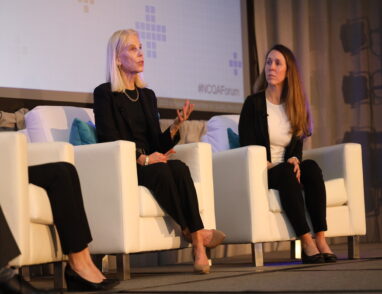Health Quality Forum, Day 2 Wrap Up: State Innovations, Social Needs Data and Reducing Disparities
April 9, 2025 · Becky Kolinski
The second day of NCQA’s Health Quality Forum explored opportunities to advance health equity and reduce disparities through community partnerships. The theme of today’s sessions: the importance of data sharing, and how organizations are overcoming challenges to data quality and standardization.
Here are some highlights and key takeaways from the forum’s second day.
Maryland’s Policy Landscape: Top Priorities
Maryland is striving to improve health equity, maternal and child health outcomes and population health. A panel of experts discussed programs on the horizon and the challenges ahead.
Key Takeaways
Programs generating excitement:
- Affordability initiatives.
- Advanced primary care and the shift from volume to value.
- Prenatal risk assessment and performance improvement project for Medicaid managed care organizations.
Areas where Maryland struggles:
- Pre-deductible coverage to tackle affordability issues—what’s the benefit of having health insurance if people can’t afford to use it?
- Health literacy, rebuilding trust in communities and connecting people to services.
- Perinatal health and racial disparities in death rates of moms and babies.
Insights from the panel:
- Public health is more important than ever—access data from public health departments, identify shared priorities and measure what matters.
- Social determinants of health continue to drive disparities. “The choices we make are the choices we have.”
Data Sharing to Address Social Needs
Addressing whole-person care requires strong connections across the health care system. Pennsylvania has built an effective statewide social needs platform to facilitate data exchange among health care and community-based organizations.
Key Takeaways
- PA Navigate is a statewide tool for social needs screening and referrals to community resources (food, shelter, transportation and more).
- The state encourages providers to screen for social needs and to work with managed care and community-based organizations to meet community needs.
- Health information organizations—regional HIEs in Pennsylvania—work with providers and managed care plans to facilitate data sharing.
- The biggest roadblock is interoperability and data standardization—statewide guidance would help.
Building a Statewide HIE: Lessons Learned
CRISP is Maryland’s state-designated HIE. We learned how it functions, data challenges the team encountered and plans for enhancement.
Key Takeaways
- CRISP leverages a master person index to link data across systems to support care delivery and coordination, population health reporting, public health and more.
- Integrating clinical, social needs and administrative data led to decreases in ED use, duplicate testing and mortality rates.
- Not all use cases require the FHIR® data format—simpler methods of information exchange work for many.
- Clinical data quality is a challenge and requires data mapping to standardize the data.
- Future plans include exploring low-risk administrative use cases for AI.
Innovating to Address Health Disparities
Addressing disparities in care requires creativity and innovation. Our panel shared its perspective on the risks and opportunities of leveraging AI, and the impact on communities.
Key Takeaways
AI can improve community health and well-being of communities—but we can’t overlook the ethical considerations:
- Automation and the elimination of jobs at the lower end of the social economic spectrum.
- The need to upskill the workforce to correspond with digital health solutions.
- The energy infrastructure needed to store, use and analyze AI data in communities.
As we innovate, it is crucial to reflect, act intentionally and be aware of the downstream impact on communities.
Using Data to Understand and Act to Address Health Disparities
Identifying health disparities is the first step—transforming insights into action is where real impact happens. Our panel explored data-driven methods to help organizations identify and address gaps in care at the population and individual levels.
Key Takeaways
- Community-based organizations are essential partners in reducing health disparities.
- Start small with a defined population, share lessons learned through regular feedback loops, leverage technology to support referrals and outcomes measurement.
- The importance of community-based intelligence: combining data with on-the-ground feedback from community organizations and patient experiences.
- Emphasize agency and empowerment when working with underserved communities, and amplify local voices: universities, health departments, neighborhood associations, community members.
Learn More
Read more updates from the Health Quality Forum:
- Health Quality Forum Opening Remarks: “We Must Raise Our Ambitions”
- Health Quality Forum, Day 1 Wrap Up: Virtual Care, Rural Access and More
Join Us!
We hope you’ll join us for the Health Innovation Summit, October 13–15 in San Diego, CA.








